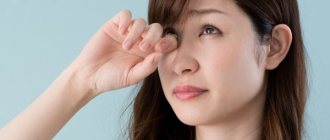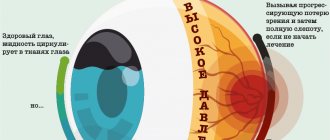Dry eye syndrome, otherwise called xerophthalmia, keratoconjunctivitis sicca or keratitis sicca, is an eye disease associated with increased evaporation of tears or decreased production of tears, which causes a feeling of dry eyes. This problem is usually characteristic of older people, although it also occurs in young people.
How does dry eye syndrome manifest?
With dry eye syndrome, the secretion of the lacrimal glands is not enough to constantly moisturize the epithelium of the organ of vision. This entails injury to the mucous membranes and inflammatory processes in them, since tears not only physically protect the surface, but also have bactericidal properties.
In older people, disruption of the formation of the tear film can be caused by a lack of vitamin A, a change in the fat balance (the secretion of the lacrimal glands includes lipids, causing an increased surface tension of the tear, which does not flow down, but “sticks” to the mucous membranes of the eye), as well as some age-related diseases, such as Parkinson's disease.
In young people, symptoms of dry eyes are often caused by constant work at the computer, so it is necessary to periodically take a break from the laptop or desktop PC. Symptoms of xerophthalmia are a sensation of a foreign body in the eye, “sand” under the eyelids, redness of the eyes, pain, burning. Which does not go away when you blink. Perhaps these signs are familiar to many residents of modern cities who use electronic devices every day for work, study, and communication on social networks. Symptoms of keratitis can also develop in drivers who spend a lot of time behind the wheel, especially at night, when special eye strain is required. Keratitis is an occupational disease of electric welders who are forced to look at a blue electric arc.
It is difficult to imagine a world without technological progress, although it often negatively affects human health, including the state of the visual organs.
Self-medication is dangerous for the eyes
It should be remembered that you can only moisturize your eyes at home using professional products. Treatment should be prescribed by a doctor after diagnosis and determination of the reasons that led to the development of xerophthalmia. Doctors do not recommend using traditional medicine as a basis for therapy, since self-medication can lead to serious consequences.
Firstly, medicinal plants, herbs and other available remedies can cause an allergic reaction. Against the background of such “stress”, the condition of the organ of vision will only worsen.
Secondly, improper treatment often leads to the progression of xerophthalmia and the development of concomitant diseases of the cornea and conjunctiva. In the absence of adequate therapy, the patient may lose visual perception.
Thirdly, any treatment must be agreed with a doctor. Only a good ophthalmologist can determine the true cause of the pathology, select the necessary treatment and the correct dosage of drugs.
Prevention of dry eye syndrome
Of course, the ideal option would be to prevent the appearance of unpleasant sensations in the eyes. Preventing a disease is always better than treating it. To do this you need:
- periodically (every 40 minutes) take a break from working at the computer (this is especially important for those who like to play computer games longer or for those whose work is impossible without a PC - journalists, financial traders, designers, programmers) and do a warm-up for the eyes - blink, massage your eyelids;
- adjust monitor settings, avoid too bright and too pale computer monitors, because they irritate the eyes,
- maintain a distance of 50-70 cm between the computer and the monitor;
- choose glasses and contact lenses correctly and wear them in accordance with the recommendation of an ophthalmologist;
- monitor the lighting (it should be comfortable for the eyes);
- consume enough fluid daily (at least 1.5 liters);
- use sunglasses on sunny days;
- try to monitor your diet and avoid hypervitaminosis and vitamin deficiencies; the body must receive a sufficient amount of microelements and vitamins, but too much can be harmful;
- do not look at the welding, because this process can also provoke the development of dry keratitis and severe inflammation of the eyes;
- use safety glasses when shooting sports, metal and wood processing, finishing and dry cleaning of premises and other dangerous and simply dusty activities;
- monitor your general health and treat diseases that can provoke inflammatory processes in the eyes (for example, Sjogren's syndrome);
- know the individual characteristics of your body (some people’s eyes are especially sensitive to irritating factors, and this must be taken into account; this also applies to allergy sufferers, because in many cases the allergen also affects the eyes, causing discomfort in them);
- Pay special attention to your eyes when there is a sudden change in climate (for example, when traveling by train to a warm sea in winter), as well as when you are constantly in rooms with very dry air (if possible, use a humidifier).
The most commonly used inexpensive drops
The main purpose is to moisturize the thin transparent tissue covering the outside of the eye, the back surface of the eyelids, and the vitreous part of the eyeball. Most often, doctors recommend
Vidisik – creates an artificial tear, lubricates the surface of the eye, reduces the possibility of its damage, enhances regeneration;
Oftagel - increases the viscosity of tears due to the presence of a carbomer (water-soluble polymer) in its composition, compacts the liquid layer of the tear film. Application reduces redness, the feeling of sand getting into the eye, stops frequent tearing; Systane - effectively affects the elimination of some eye diseases, retains moisture for a long time, does not disturb the surface of the cornea; Hilo-chest is the most effective after eye surgery; it is used in the treatment of injuries to the anterior transparent part of the eyeball. Eliminates burning and dryness. Recommended for use when wearing lenses; Licontin Comfort is indicated for people who are accustomed to wearing transparent lenses worn directly on the eyes, used for vision correction.
Does not have a negative effect on their transparency, strengthens the tear film. Children under seven years of age are most often susceptible to eye inflammation. Ophthalmologists advise parents to purchase antibacterial (Albucin, Floxal, Tobrex), antiviral (Interferon, Tebrefen, Florenal), antiallergic (Cromhexal, Allergodil, Opatanol), preservative-free eye drops for children. The main rule is not to self-medicate.
The use of the necessary eye drops that do not have a negative effect on vision, the conditions, and the procedure for their use can only be recommended by a professional doctor - an ophthalmologist after a complete examination of the child.
What should a person who is faced with the problem of irritated eyes do?
Unfortunately, not everyone takes preventative measures, and many people develop dry eyes. What happens next depends on the severity of the disease and the presence of complications (this could be perforation of the cornea, visual impairment, ulcers on the sclera). Nowadays, dry keratitis can be treated with synthetic drugs, surgical methods, laser and folk remedies.
Synthetic gels and drops
Synthetic drugs for the treatment of dry eye syndrome include, for example, Cornergel and Oftagel. They moisturize the cornea of the eye and alleviate the symptoms of the disease, preventing its complications. There are also numerous drops for dry eyes, discussed in detail on the website.
Surgical treatment and laser
Surgical methods for treating xerophthalmia consist of blocking the lacrimal openings and plasticizing them. Surgical suturing, laser coagulation and diathermocoagulation are also possible. When choosing a method, the individual characteristics of the patient’s eyes, the degree of neglect of the syndrome and the presence of related diseases (inflammatory processes, retinopathy, cataracts, glaucoma, optic nerve atrophy) are taken into account.
However, there are also traditional methods of combating dry eye syndrome. We will talk about them below.
DIY eye drops
You can prepare eye drops at home yourself. The main component of the drops is honey. Honey is a magical product; it contains large quantities of enzymes, vitamins and microelements.
In folk medicine, it is a harmless and highly effective medicine. Honey-based eye drops not only help with dry eyes, but also restore vision.
1.Honey solution
To prepare the solution, use honey (preferably acacia) from the current year and dilute it with water, stirring well. Many sources offer boiled water, but I, as a pharmacist, use 5 ml water for injection. Scheme for the treatment and prevention of dry eye syndrome:
- 1 day - 1 tsp of honey diluted in 10 ampoules of 5 ml of water for injection (1:10)
- Day 4 - dilute in a ratio of 1:9
- Day 7 – in a ratio of 1:8
- Day 10 - make a solution of 1:7 and so on until we reach a dilution of 1:3
Instill drops 1-2 drops 3 times a day. Store the prepared solution in the refrigerator.
2.Aloe with honey
To prepare the drops, we use the lower leaves of aloe vera at least three years old. The older the plant, the richer its healing properties.
Before cutting the leaves, do not water the plant for two weeks. Cut, wrap in a bag and place in the refrigerator for two weeks. Before cooking, cut the leaves in half and use a spoon to scrape the pulp into cheesecloth and squeeze out the juice.
Mix in the proportion of 1 tsp (5ml) honey with 1 tsp (5ml) aloe juice adding 10 ml water for injection (ratio 1:1:2). Store in the refrigerator for no more than 7 days in a dark jar, well sealed. Instill 1-2 drops 3 times a day.
Advice! In order for the drops to be warm when instilled, first pour part of the solution into a hot spoon and from there draw the solution with a pipette.
In these simple ways you can slow down the process of dry eyes and nourish them with vitamins.
Advice! Help your body from the inside.
To get a greater source of vitamins and keep your eyes healthy, use vitamin-mineral complexes.
And your eyes will definitely thank you with good vision and clear eyes.
Experienced pharmacist Irina Voitova was with you
Source
Traditional recipes for the treatment of dry keratitis
Nowadays, there are many folk recipes that alleviate dry keratitis. What is the treatment of dry eyes with folk remedies? Folk methods of dealing with this problem are very diverse.
Of course, our ancestors used these tools without knowing anything about computers or contact lenses. But eye diseases have always existed, only they were caused by other reasons.
Most folk remedies designed to combat eye irritation and inflammation are lotions or decoctions and herbal extracts for rinsing.
For lotions, chamomile and aloe are most often used. These plants have a pronounced bactericidal and anti-inflammatory effect, and their use allows you to solve two urgent problems at once: moisturize the cornea and other surfaces of the eye and prevent the proliferation of pathogenic microorganisms there.
Sore, dry eyes are also washed with herbal decoctions. For this purpose, it is worth using chamomile, violets, pansies and rosemary. You need to take 2-3 tablespoons of herb per 200 ml. boiling water and wait 1 hour until the medicine infuses. Then the broth is filtered and used 3-4 times a day. Herbs can be used individually or in combination - there are no problems with drug interactions, the main thing is that there are no symptoms of individual intolerance to one of the components of the collection.
Ready-made decoctions for washing and extracts for applications should be kept in the refrigerator to prevent the development of microbes and molds in them. Before use, a small portion of the broth is poured into a cup and heated in a microwave oven or on the stove to room temperature. A decoction that is too hot or cold should not be used for the procedure.
Green tea is the best vision protector
Green tea lotions have also long been very popular. It has proven itself as an excellent anti-inflammatory and moisturizing agent. Leaves are taken from well-brewed and cooled tea, wrapped in gauze, wrung out and placed on the eyelids. The duration of the procedure is 15 minutes. The fluid should seep into the eye. The procedure should be taken while lying on your back.
Warm-moist compresses.
When used, blood flow to the eyelids increases, the tear film stabilizes, and the volume of tear fluid increases. They help with inflammation of the eyelids and malfunction of the glands inside the eyelids.
One of the most common methods is the use of tea bags.
- Tea bags . Take warm tea bags (never hot) with drunk tea and place them on both eyes for a few minutes. Do not allow the bag to cool so that the warm compress turns into a cold one. The compress is applied for 3-5 minutes. During the procedure, we lower it several times into warm water.
- Chamomile in filter bags. Fill 6 sachets with boiling water, wait until the water becomes warm and apply alternately every two sachets after a minute. The result is 3 minutes of warm compress.
Chamomile can be alternated with thyme, calendula, and marshmallow.
- Kalanchoe juice . This compress will take longer. Cut off the Kalanchoe leaves and place them in the refrigerator for a week. Then cut it in half and scrape out the pulp with a teaspoon. Squeeze and store the finished juice in the refrigerator. For a compress, dilute 1 part juice with 1 part hot water and apply a warm compress to the eyes. Cover the top with a warm towel. Let stand for 2-3 minutes
It is advisable to do compresses daily, 2 times a day for 14 days.











